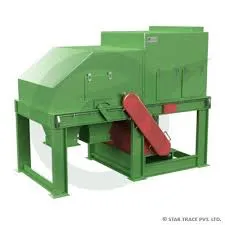Granulators play a pivotal role in the manufacturing and recycling industries, providing a crucial solution for material size reduction. Their functionality hinges on their ability to efficiently process various materials into smaller, uniform particles, which are then easier to handle, process, or recycle. Understanding how a granulator works not only highlights its importance but also its versatility across different sectors.

At the heart of a granulator is its cutting mechanism, designed to transform large pieces of material into smaller granules. This is achieved through a system of rotating knives and stationary knives, known as the rotor and stator, respectively. As the rotor spins at high speeds, the material fed into the granulator is sheared by these knives. The result is a consistent particle size, crucial for subsequent processing steps such as extrusion or molding.
The performance of a granulator largely depends on three key factors knife configuration, screen size, and the material being processed. The knives need to be sharp and strategically arranged to ensure clean, precise cuts without unnecessary energy consumption. Periodic maintenance, including sharpening and adjusting the knives, maximizes efficiency and prolongs the machine's lifespan. On the other hand, the screen size controls the final granule size. A smaller screen mesh results in finer granules, suitable for applications that demand precision.

Granulators are equipped with robust motors to handle various material densities and composition, from plastics to metals and even organic waste. This adaptability makes them indispensable in recycling operations, where they aid in transforming waste into reusable forms, thereby contributing to environmental sustainability efforts. Additionally, advanced granulators today offer automated systems to adjust processing parameters on-the-fly, ensuring that even the most challenging materials are handled with ease.
how does a granulator work
Safety is paramount when operating a granulator. These machines are designed with numerous safety features to protect operators from potential hazards. Safety interlocks, emergency stop buttons, and protective enclosures are standard. It’s crucial for operators to receive comprehensive training on both operation and safety procedures, ensuring the machine's effective and secure use.
The applicability of granulators extends beyond just recycling or size reduction. In pharmaceutical and food industries, granulation is a critical step in achieving the right product consistency and blend uniformity. Here, they play a role in converting powders into granules for tablets or capsules, enhancing flowability and compressibility. This highlights the expert engineering behind granulator design—tailored to meet industry-specific demands.
In essence, granulators exemplify the union of engineering prowess and industrial necessity. Their ability to reduce, recycle, and refine material substantiates their indispensable presence in various manufacturing sectors. As technology continues to advance, we can anticipate further innovations in granulator technologies, fostering efficiency and sustainability in operations across the globe. Understanding and leveraging their capabilities is fundamental for businesses aiming to optimize production processes and adhere to environmental regulations, securing a competitive edge in the ever-evolving marketplace.


